
A fortification is a military construction designed for the defense of territories in warfare, and is used to establish rule in a region during peacetime. The term is derived from Latin fortis ("strong") and facere.
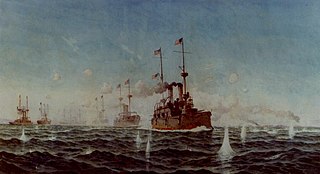
The Battle of Manila Bay, also known as the Battle of Cavite, took place on 1 May 1898, during the Spanish–American War. The American Asiatic Squadron under Commodore George Dewey engaged and destroyed the Spanish Pacific Squadron under Contraalmirante Patricio Montojo. The battle took place in Manila Bay in the Philippines, and was the first major engagement of the Spanish–American War. The battle was one of the most decisive naval battles in history and marked the end of the Spanish colonial period in Philippine history.

The Philippine peso, also referred to by its Filipino name piso, is the official currency of the Philippines. It is subdivided into 100 sentimo, also called centavos.

Banknotes of the Philippine peso are issued by the Bangko Sentral ng Pilipinas for circulation in the Philippines. The smallest amount of legal tender in wide circulation is ₱20 and the largest is ₱1000. The front side of each banknote features prominent people along with buildings, and events in the country's history while the reverse side depicts landmarks and animals.

Intramuros, is the 0.67-square-kilometer (0.26 sq mi) historic walled area within the city of Manila, the capital of the Philippines. It is administered by the Intramuros Administration with the help of the city government of Manila.
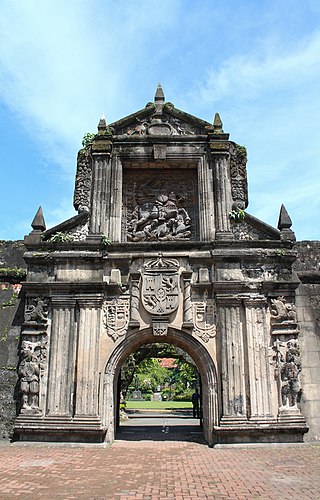
Fort Santiago, built in 1571, is a citadel built by Spanish navigator and governor Miguel López de Legazpi for the newly established city of Manila in the Philippines. The defense fortress is located in Intramuros, the walled city of Manila.

The Bangko Sentral ng Pilipinas is the central bank of the Philippines. It was established on July 3, 1993, pursuant to the provision of Republic Act 7653 or the New Central Bank Act of 1993 as amended by Republic Act 11211 or the New Central Bank Act of 2019. The principal author was Senator Franklin Drilon. It was signed by President Rodrigo Duterte.

Miguel Malvar y Carpio was a Filipino general who served during the Philippine Revolution and, subsequently, during the Philippine–American War. He assumed command of the Philippine revolutionary forces during the latter, following the capture of resistance leader Emilio Aguinaldo by the Americans in 1901. According to some, he could have been listed as one of the presidents of the Philippines. However, is not recognized as such by the Philippine government.

Malate is a district of Manila, Philippines. Together with the district of Ermita, it serves as Manila's center for commerce and tourism.
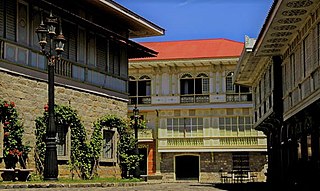
The architecture of the Philippines reflects the historical and cultural traditions in the country. Most prominent historic structures in the archipelago are influenced by Austronesian, American architectures.

The Philippine peso fuerte was the first paper currency of the Philippines and the Spanish East Indies during the later Spanish colonial period. It co-circulated with other Spanish silver and gold coins and was issued by El Banco Español Filipino de Isabel II. The banknotes were convertible to either silver pesos or gold coins at the bank's discretion. The colonial government at the time allowed El Banco Español-Filipino to issue pesos fuertes up to one-fourths of its subscribed capital, or a maximum of PF 100,000, which was subsequently raised to 300,000 in 1855.
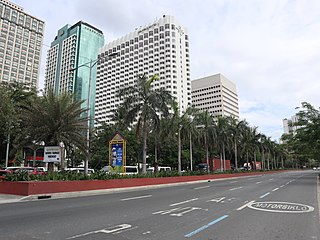
Roxas Boulevard is a popular waterfront promenade in Metro Manila in the Philippines. The boulevard, which runs along the shores of Manila Bay, is well known for its sunsets and stretch of coconut trees. The divided roadway has become a trademark of Philippine tourism, famed for its yacht club, hotels, restaurants, commercial buildings and parks.

The Spanish fortifications of the Philippines, or fuerzas, are strongholds constructed by Filipinos and Spaniards primarily for protection against local and foreign aggressors during the Spanish colonial period, and during the subsequent American and Japanese occupations. Structures built included fortresses, watchtowers, and bastions. Many are badly damaged, either due to old age or past conflicts. Currently, there are initiatives for restorations of all forts, beginning when the Baluarte Luna of La Union and the Intramuros of Manila were restored in the 2010s. In 2013, a typhoon and earthquake hit Central Visayas and damaged numerous Spanish fortifications, leading to the largest restoration activity for fortifications in Philippine history.
The New Design Series (NDS) (also known as the BSP Series after the establishment of the Bangko Sentral ng Pilipinas) was the name used to refer to banknotes of the Philippine peso issued from 1985 to 2013 and the coins of the Philippine peso issued from 1995 to 2017. The banknotes were printed until 2013 (with 5-peso note were printed until 1995, 10-peso note until 2001, 20 and 1000 peso notes until 2012, and 50, 100, 200 and 500 peso notes until 2013), legal tender until December 31, 2015, and can be exchanged with NGC notes until its demonetization on January 3, 2018 where they co-existed with the NGC banknotes from December 16, 2010 to January 3, 2018. The coins were minted and issued from c. December 1995 to November 30, 2017, and remain legal tender as of 2023. It was succeeded by the New Generation Currency (NGC) Series issued on December 16, 2010, for banknotes and November 30, 2017, for coins.

The Philippine fifty-peso note (₱50) is a denomination of Philippine currency. Philippine president and former House Speaker Sergio Osmeña is currently featured on the front side of the bill, while the Taal Lake and the giant trevally are featured on the reverse side.

Pablo Ocampo Street, also known simply as Ocampo Street and formerly and still referred to as Vito Cruz Street, is an inner city main road in Manila, Philippines. It runs west–east for about 3.448 kilometers (2.142 mi) connecting the southern districts of Malate and San Andres southeast to the adjacent city of Makati.
San Antonio Abad may refer to
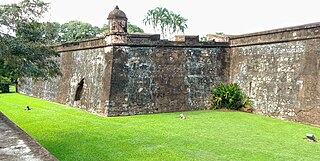
The Fortaleza de San Fernando is a colonial-era Spanish fortress in Omoa, Honduras. Built between 1756 and 1775, the fortress guarded Spanish interests in the-then Captaincy General of Guatemala before being seized by the Honduran government in 1821. The fortress remains relatively intact, and is a major tourist attraction in Omoa.

Martin Jesus Imperial Tadeo Tinio Jr., more popularly known as Sonny Tinio, was a Filipino antiquarian, art historian, interior designer, architect, author, and cultural worker. He was best known for chronicling the history of Philippine colonial architecture and Philippine antiquities in various publications in both the Philippines and overseas.





















